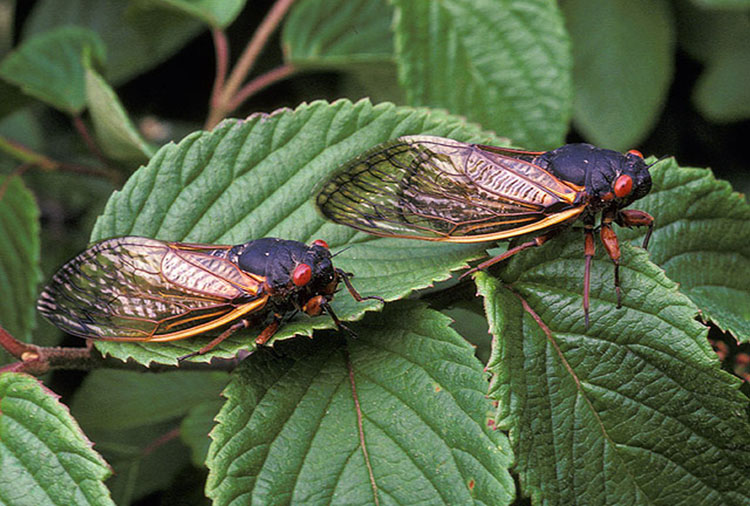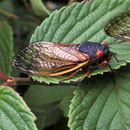 |
|---|
| Billions of cicadas have started emerging and taking to the trees in the eastern United States after growing underground for 17 years. |
 
|
Cicadas getting ‘high, horny, super-sexed’ from fungus that makes their butts fall off, experts say
NJ.com
Fri May 21, 2021
What’s more terrifying than an army of billions of cicadas waking up from a 17-year underground slumber and blanketing neighborhoods like a biblical plague? Fungus-ridden, speed-fueled, sex-crazed cicadas, probably.
A fungus called Massospora cicadina has been infecting some Brood X cicadas, the legion of red-eyed insects that have been hibernating underground for nearly 17 years, according to insect experts.
Although this fungus was first discovered in the 1800s, researchers recently learned more about how the fungus affects the mating behavior of periodical cicadas — the groups that emerge just once every decade or two.
The researchers found the fungus has chemicals similar to those in hallucinogens, like psychedelic mushrooms, said Gene Kritsky, a cicada expert from the Mount St. Joseph University in Ohio who contributed to the study.
The effects of the fungus are strange, but true.
“It causes their butts to fall off,” Kritsky told NJ Advance Media, noting the fungus attacks male cicadas, so they lose their genitals and are no longer able to reproduce.
However, it won’t stop them from trying.
Kritsky said male cicadas who are infected with the fungus will continue to behave as if they are drug-induced and have their bodies intact. They will continue to sing loudly to attract females, and sometimes they even mimic the behavior of the females by flicking their wings.
“You’ve got high, horny, super-sexed periodical cicadas,” Kritsky said.
When the infected male cicadas flick their wings, that sometimes causes healthy male cicadas to get tricked into thinking they are females, Kritsky noted. And if they have contact with the infected males, the healthy ones too can get the fungus and pass it on to other cicadas.
How the fungus attacks
The fungus first causes the cicadas’ rear ends to fall off — including their genitals — and be replaced with white fungus, making the cicadas look like they have an eraser end for a butt, according to an NPR report. The fungus then floods the cicada’s system with compounds of cathinone, an amphetamine.
The cathinone then makes the cicadas go wild, pushing their sex drive into overdrive, with the cicadas furiously attempting to mate, despite no longer having the required appendages.
The fungus infects the cicadas right before they emerge from the ground and causes the insects’ butts to fall off when they begin shedding as they become adults, the report says.
Overall, the fungus is believed to infect only about 5% to 10% of the periodical cicadas, Kritsky said. With billions — and perhaps even trillions — of cicadas storming out of the ground in the eastern United States during the next few weeks, there will still be plenty of mating going on and no threat to the survival of the Brood X species, he said.
So they will be back again in another 17 years and repeating the mating process.
The cicada invasion of 2021 started during recent weeks in some states, with the biggest emergences reported in Maryland, Ohio and Tennessee.
So far, a few hundred cicada sightings have been reported in New Jersey — mostly in Mercer, Hunterdon and Somerset counties — but a big explosion is expected as soon as soil temperatures consistently warm up to 64 degrees. That could be next week, based on recent soil temperature data from the Rutgers NJ Weather Network.
Experts say one of the hot spots in New Jersey will be the Princeton area of Mercer County, which had many documented sightings of Brood X cicadas during their earlier invasions dating all the way back to the early 1800s.
Other hot spots include Kingwood and Lambertville in Hunterdon County.
Kritsky, the cicada expert from Mount St. Joseph, even created a phone app to report and track sightings of the crimson-eyed invaders. With interest in these mysterious bugs growing, the number of people downloading the app has skyrocketed during the past few weeks.
“We were hoping to get 50,000 (downloads). We have 143,000 now,” Kritsky told NJ Advance Media on Friday.
With thousands of cicada sightings and thousands of photos being submitted each day, he said, “it’s probably the largest response of a cicada crowd-sourcing project in the history of the cicadas.”


 Share your thoughts in the Forum
Share your thoughts in the Forum